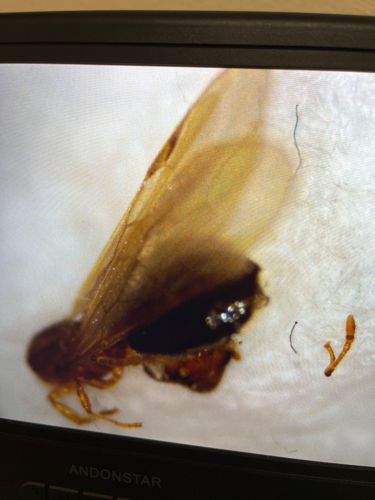Winged Termite (likely a swarmer)
Scientific Name: Varies by species, but generically 'Isoptera' or a specific genus and species if more detail was available (e.g., Reticulitermes flavipes for Eastern subterranean termite or Kalotermes flavicollis for drywood termite).
Order & Family: Order Isoptera (now considered part of Blattodea); various families, likely Rhinotermitidae (subterranean termites) or Kalotermitidae (drywood termites) based on the image, though precise family identification is difficult from this image alone.
Size: Winged termites (swarmers) typically range from 0.2 to 0.5 inches (5-13 mm) in length, including their wings. Workers and soldiers are generally smaller.

Natural Habitat
Termites are found in a wide variety of habitats globally, though they are most common in tropical and subtropical regions. They build nests in soil, wood, or mounds. Winged termites, as seen here, are typically encountered when they swarm to establish new colonies.
Diet & Feeding
Termites are detritivores, primarily feeding on dead plant material, including wood, leaf litter, and soil. They possess symbiotic microorganisms in their gut that enable them to digest cellulose.
Behavior Patterns
Termites are social insects living in colonies that can range from a few hundred to several million individuals. They are known for their sophisticated nest building, which can include intricate networks of tunnels and chambers. Reproductive adults (alates, or swarmers) are winged and emerge from the colony to mate and establish new colonies. Workers and soldiers are wingless and perform colony maintenance duties. They are cryptic insects, often remaining hidden within wood or soil.
Risks & Benefits
Potential Risks: Termites are significant pests worldwide, causing extensive damage to wooden structures, furniture, and other cellulose-containing materials. Subterranean termites can damage building foundations, while drywood termites infest wood directly. Potential Benefits: In natural ecosystems, termites play a crucial role as decomposers, breaking down dead wood and plant material, thus recycling nutrients back into the soil. They also aerate the soil and can be a food source for other animals.
Identified on: 9/4/2025